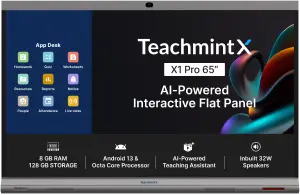In today’s digital age, educational institutions are rapidly integrating advanced technology into their classrooms to create more engaging and interactive learning environments. The interactive flat panel is among the most impactful technological tools transforming modern education. Particularly in a culturally rich and academically vibrant city like Kolkata, adopting cutting-edge tools like interactive flat panels in Kolkata schools and colleges can redefine traditional teaching methods. However, simply installing these devices isn’t enough. Comprehensive training for educators is crucial to unlocking the full potential of this technology.
Why Interactive Flat Panels Are Essential for Modern Classrooms
An interactive flat panel in Kolkata brings together the functionalities of a whiteboard, projector, and computer into one powerful tool. With features like high-definition displays, touch-screen interactivity, and seamless integration with educational software, these panels provide teachers with the ability to create dynamic, multimedia-rich lessons.
By using videos, animations, 3D models, and interactive quizzes, teachers can transform abstract concepts into engaging learning experiences. However, without proper training, these panels risk being underutilized or used in a limited capacity, preventing schools from fully benefiting from their investment in interactive flat panels.
Why Training Educators is Crucial
1. Maximizing Engagement and Interaction
The core advantage of using an interactive flat panel is the ability to make lessons more interactive and engaging. Training educators on how to use these panels effectively can help them design lessons that actively involve students. Imagine a history teacher conducting a virtual tour of ancient civilizations or a biology teacher using 3D models to explore the human body—all made possible with interactive technology.
Without proper training, educators might resort to using the panel simply as a large display screen, missing out on its interactive potential. Training ensures they can fully utilize built-in tools like interactive whiteboards, annotation features, and multimedia integration.
2. Building Technological Confidence
Not all teachers are naturally tech-savvy, and introducing new technology can be intimidating. Training programs tailored for interactive flat panels in Kolkata help educators overcome this barrier by familiarizing them with the panel’s interface, features, and troubleshooting methods.
With hands-on training, teachers become more confident in navigating the system, integrating educational apps, and using advanced features such as split-screen displays and real-time collaboration tools. This confidence translates to smoother, more effective classroom instruction.
3. Integrating with Digital Learning Tools
One of the most powerful aspects of an interactive flat panel is its compatibility with digital learning platforms and tools. It can easily integrate with popular learning management systems (LMS) like Google Classroom, Microsoft Teams, and educational apps that promote interactive learning.
Training educators ensures they know how to merge these platforms with classroom instruction, enabling seamless assignment submissions, collaborative projects, and interactive quizzes. This integration creates a dynamic learning environment that bridges traditional and modern teaching methodologies.
4. Adapting Lessons for Diverse Learning Styles
Every classroom is diverse, with students having different learning preferences. Some students learn best through visuals, others through auditory input, and some through hands-on activities. An interactive flat panel can cater to all these learning styles, but teachers need proper training to adapt lessons accordingly.
Through professional development, educators learn how to diversify their teaching strategies using videos, simulations, and real-time collaboration tools to ensure every student can engage effectively with the lesson.
5. Encouraging Collaborative Learning
Collaboration is a vital skill in the modern world, and interactive flat panels are perfect for fostering this skill. Multi-touch functionality allows several students to interact with the panel simultaneously, enabling group projects and discussions.
Training teachers to design collaborative activities ensures that they can leverage this feature to promote teamwork, problem-solving, and communication skills in the classroom.
6. Keeping Up with Technological Advancements
Educational technology evolves rapidly, and regular training ensures that teachers stay updated with the latest features and updates. Manufacturers frequently release new software updates, features, and educational tools for interactive flat panels. Continuous professional development helps educators keep pace with these advancements and apply them effectively in the classroom.
How to Implement Effective Training Programs
To ensure that teachers can maximize the potential of an interactive flat panel, schools must invest in comprehensive training programs. Here are some key strategies:
1. Hands-On Workshops
Interactive workshops offer educators the chance to practice using the panel in real-life teaching scenarios. These sessions should cover essential functions, interactive tools, troubleshooting, and integration with other classroom technologies.
2. Subject-Specific Training
Different subjects require different teaching approaches. Customized training modules tailored to specific subjects can help teachers understand how to incorporate interactive technology into their unique curricula. For example, math teachers might learn how to use graphing tools, while science teachers can explore virtual labs and simulations.
3. Peer Learning and Mentorship
Encouraging collaboration among educators can foster a culture of continuous learning. Experienced teachers can mentor others, sharing creative ways to use interactive flat panels. This peer-to-peer learning model promotes innovation and builds a supportive community of educators.
4. Access to Online Resources
Supplemental online training materials, including tutorial videos, webinars, and user manuals, offer teachers continuous learning opportunities. These resources are especially beneficial for new hires or those unable to attend in-person training sessions.
5. Ongoing Technical Support
Reliable technical support ensures that teachers can quickly resolve technical issues, minimizing classroom disruptions. Schools should provide easy access to technical assistance and regular system updates for their interactive flat panels.
Long-Term Benefits of Training Educators
Investing in professional development for teachers using interactive flat panels in Kolkata yields numerous benefits:
- Enhanced Student Engagement: Teachers can create interactive lessons that captivate students and encourage participation.
- Improved Academic Performance: Hands-on, engaging lessons contribute to better comprehension and retention.
- Efficient Use of Resources: Trained teachers maximize the use of school investments in technology.
- Future-Ready Classrooms: Educators can equip students with skills needed in the digital world.
Conclusion
Adopting advanced educational tools like interactive flat panels is an important step toward modernizing classrooms. However, the true value of this technology is realized only when educators are fully equipped to use it effectively. Comprehensive training empowers teachers to harness the full potential of interactive panels, fostering engaging, inclusive, and dynamic learning environments.
By investing in continuous professional development, schools ensure that their investment in interactive flat panels in Kolkata delivers long-term educational benefits. Empowered educators inspire curious, capable students—and that is the key to creating future-ready classrooms in Kolkata and beyond.

